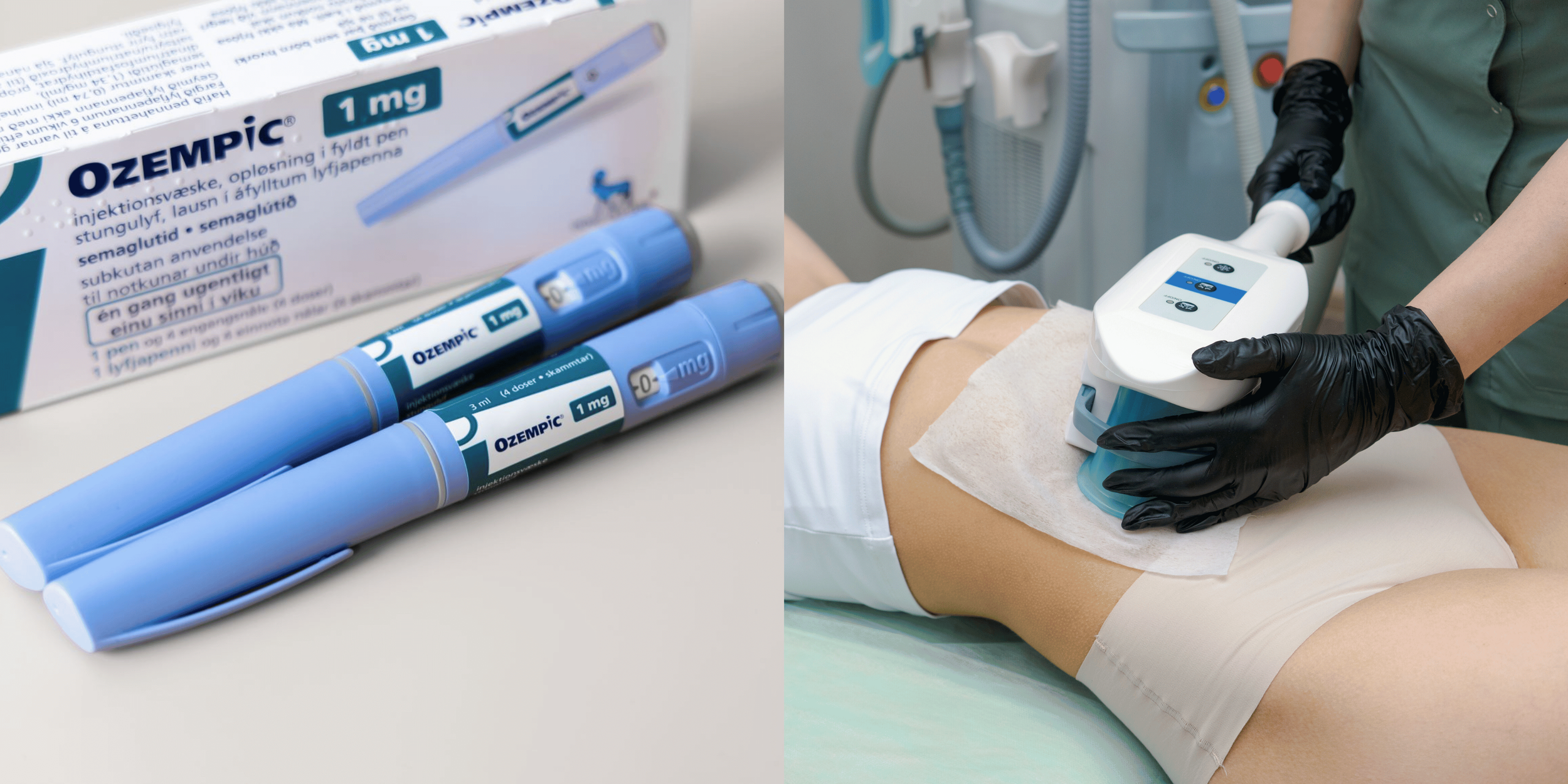
Fat Freezing vs Ozempic: Understanding your options
Comparing fat freezing (Cryolipolysis) and Ozempic to find the best non-invasive fat reduction treatment for your need. Learn about the mechanisms, efficacy, and suitability for long-term results.
Key Takeaways
Fat freezing is non-invasive and ideal for targeted fat loss with permanent and fast results.
Ozempic and other GLP-1/ GIP medications are effective for general weight loss by reducing the size of the fat cells throughout the entire body by suppressing appetite and slowing digestion. However, long-term use may be necessary and potential side-effects should be considered.
The decision between these treatments should be made upon consideration of individual health, lifestyle, and weight loss goals.
Consulting a healthcare professional is essential to ensure safety and most suitable treatment selection.
INTRODUCTION
In recent years, the demand for faster and more effective ways to lose weight has driven the development of more innovative non-invasive and invasive fat loss methods. Among the most notable options that have gained worldwide attention are Ozempic, and other weight loss drug versions, and Fat freezing / Coolsculpting.
Fat freezing is a non-invasive cosmetic procedure designed to target and eliminate fat in specific areas. By using controlled cooling, the procedure freezes and destroys fat cells, which are then naturally removed by the body over time.
On the other hand, medications like Ozempic, Mounjaro, and Wegovy were originally developed for managing type 2 diabetes. However, these drugs have also proven effective for weight loss, as they help regulate appetite and blood sugar levels, leading to generalised fat reduction.
Both fat freezing and weight loss medications like Ozempic offer effective solutions for weight loss, but the choice between them depends on individual health, lifestyle, and personal goals. Ensuring the safety and efficacy of these treatments is crucial, and a thorough understanding of each option, coupled with professional consultation, will help you choose the approach that best aligns with your needs.
Global vs Targeted Fat Loss
To understand the difference between targeted fat loss and global fat loss, it is essential to distinguish the different types of area that fat is stored in the body. Fat cells are stored in the body as either subcutaneous or visceral fat. While subcutaneous fat is located just beneath the skin, most commonly found around the hips, buttocks, thighs, and abdomen — this is the fat that can be pinched with your fingers. Visceral fat, on the other hand, is stored deeper in the body, underneath the abdominal muscles and around internal organs and is the type of fat is associated with a higher risk of health issues, such as diabetes and heart disease.
For more information, check out our blog Subcutaneous vs Visceral Fat.
When it comes to global fat loss, as seen with GLP-1 and GIP medications like Ozempic, both subcutaneous and visceral fat cells shrink in size. However, the fat cells remain intact, meaning they can expand again any time if the body's energy intake exceeds energy expenditure or if the metabolic and hormonal system signal the need to store more energy. This can result in weight regain, especially if the medication is discontinued.
In contrast, fat freezing specifically targets subcutaneous fat, resulting in the permanent destruction of fat cells in the treated area. Once these fat cells are destroyed, they will be removed from the body through natural processes, leading to permanent fat reduction in the targeted area.
This distinction is important when comparing these two methods of fat loss, as fat freezing offers a localised, permanent solution, while medications like Ozempic focus on broader (but not permanent) fat reduction.
To learn more about the most current and popular weight loss, fat loss, and cosmetic body contouring treatments, check out our e-book ‘TRIMMING THE FAT -AN ESSENTIAL GUIDE TO THE TOP 15 WEIGHT LOSS INTERVENTIONS’
Understanding Ozempic (GLP-1 receptor agonists)
-
Glucagon-like peptide-1 (GLP-1) and glucose-dependent insulinotropic polypeptide (GIP) receptor agonists are medications originally developed to manage type 2 diabetes but are now widely used for weight loss.
These drugs work by targeting either both GLP-1 and GIP receptors or the GLP-1 receptor alone. Ozempic and Wegovy (generic name: Semaglutide), among the most well-known in this category, are GLP-1 receptor agonists. Newer drugs like Mounjaro (generic name: Tirzepatide) act as dual agonists, targeting both GLP-1 and GIP receptors.
The role of a receptor agonist is to bind to specific receptors in the body’s cells, mimicking the action of naturally occurring peptides like glucagon. By activating these receptors, the drugs produce similar effects to the body’s natural processes, but with the administered medication substituting for the body’s own production and release of these peptides. This mechanism helps regulate appetite, blood sugar, and, consequently, contributes to weight loss.
-
Ozempic was the first GLP-1 receptor agonist drug that was approved for use in adults with type 2 diabetes in 2017. It works by mimicking GLP-1, a naturally occurring peptide, increasing insulin levels in the body and lowering the amount of sugar released into the bloodstream. The FDA (Food and Drug Administration) or the TGA (Therapeutic Goods Administration) has not approved Ozempic for weight loss but its off-label use is what has hit the headlines in the last few years and as such the further development of and production of other similar products - namely Weygovy, Mounjaro.
Ozempic and Weygovey are considered convenient as they only require a weekly subcutaneous injection (injection onto the fat under the skin) that can be done at a time that suits you. They also manage blood sugar levels and have cardiovascular benefits, making them ideal for people with type 2 diabetes. Studies show that Semaglutide, the active ingredient, is effective in promoting weight loss in doses larger than what is found in Ozempic. The FDA and TGA have approved Wegovy, a drug containing larger doses of Semaglutide, for chronic weight loss. Since Wegovy is not as accessible as Ozempic and is usually not covered by insurance, people have continued to use Ozempic.
Studies have shown that Semaglutide can lead to a 5-20% weight loss especially when used in addition to lifestyle modification. It also leads to a generalized weight loss. However, studies have also shown that around 40% of the weight loss is from the loss of muscle and not fat leading to a lower metabolic rate. In addition, negative adaptation of the body will lead to weight gain in ⅔ of people when the medication is stopped. Ozempic is not safe for everyone and should be avoided in those with pancreatitis, type 1 diabetes, pregnant or breastfeeding, diabetic retinopathy, family history of thyroid carcinoma, and under 18 years of age.
-
Pros:
Rapid weight loss in the initial few weeks due to reduction of appetite.
Reduced fat cells size resulting in global weight loss
Both visceral and subcutaneous fat cells reduce in size
No need for increased exercise
No need to change diet quality, although recommended for faster result
Cons:
Global and sudden weight loss results in rapid aging and gaunt appearance.
No increase in dietary knowledge and therefore no change in behavior once treatment ceases
Costs +400$ per month and the recommendation is for long-term use so the average cost per year is +4800$
Temporary as weight gain occurs once injections stop
Muscle loss occurs with rapid weight loss and severe calorie restriction
Long-term side effects on health
Understanding Fat Freezing (Cryolipolysis)
-
Fat freezing/ cryolipolysis is a non-invasive procedure that uses controlled cooling to target and eliminate fat cells. A panelled or cupped device is applied to the treatment area, freezing the fat cells without harming the surrounding skin, muscles, or nerves. This makes fat freezing an ideal solution for addressing stubborn fat in specific areas, such as the chin, underarms, back or bra rolls, love handles, abdomen, thighs, calves, and knees.
The freezing process causes fat cells to crystallize and die, after which they are broken down by immune cells called macrophages and gradually removed through the lymphatic system. The procedure is performed without the need for general or local anesthesia. Once the fat cells are destroyed during the treatment, they are permanently eliminated from the body.
During the procedure, clients may initially feel a sensation of tugging or pulling as the tissue is drawn into the vacuum applicator. A slight stinging may also occur as the area becomes numb. After the procedure, it is common to experience temporary numbness and tingling due to the cold exposure, but these sensations typically resolve within a few days.
-
Fat freezing has been studied extensively in both animal and human models. The results have been excellent with visible and fast results. The effects can be visible in as little as 2-4 weeks after treatment with final results showing up to a 25% reduction in fat. This efficacy is seen with only 1-2 sessions, proving its superiority. Fat reduction is permanent during freezing because the cells are removed from the area, leading to a long-lasting solution to stubborn fat pockets and bulges. Patients are highly satisfied even after just one session of this therapy because of this effect.
A study by Krueger et al. (2014) quotes two additional studies and states, “The clinical efficacy and safety of cryolipolysis has been studied in both human and animal models. In two separate studies, animal models demonstrated a reduction of up to 1 cm or 40% of the total fat layer thickness after a single exposure without harming the overlying skin.” (Manstein et al., 2008 & Zelickson et al., 2009)
An additional reference included in this study - refers to the article by Coleman SR et al, titled “Clinical efficacy of noninvasive cryolipolysis and its effects on peripheral nerves” States that “in a study published in 2009 involving ten subjects reported a 20.4% and 25.5% reduction in the fat layer 2 months and 6 months after treatment, respectively
References:
Coleman, S. R., Sachdeva, K., Egbert, B. M., Preciado, J., & Allison, J. (2009). Clinical efficacy of noninvasive cryolipolysis and its effects on peripheral nerves. Aesthetic Plastic Surgery, 33(4), 482–448. https://doi.org/10.1007/s00266-009-9336-0
Krueger, N., Mai, S. V., Luebberding, S., & Sadick, N. S. (2014). Cryolipolysis for noninvasive body contouring: Clinical efficacy and patient satisfaction. Clinical, Cosmetic and Investigational Dermatology, 7, 201-205. https://doi.org/10.2147/CCID.S44371
Manstein, D., Laubach, H., Watanabe, K., Farinelli, W., Zurakowski, D., & Anderson, R. R. (2008). Selective cryolysis: A novel method of non-invasive fat removal. Lasers in Surgery and Medicine, 40(9), 595–604. https://doi.org/10.1002/lsm.20719
Zelickson, B., Egbert, B. M., Preciado, J., et al. (2009). Cryolipolysis for noninvasive fat cell destruction: Initial results from a pig model. Dermatologic Surgery, 35(10), 1462–1470. https://doi.org/10.1111/j.1524-4725.2009.01259.x
-
Pros:
Results in permanent fat loss with as little as 1 session
Doesn't require general or local anesthetic
Most clients see a visible reduction within 2-3 weeks
Effective results at 12 weeks due to the removal of fat cells via the lymphatic system
Fewer treatments are required to reach the desired result when compared with other non-invasive treatments
Targeted fat loss
No dietary changes required
Little to no downtime
Cons:
The feeling of pulling during the procedure
Mild stinging sensation as the skin becomes numb that may last a few days after treatment
Repeated sessions may be needed depending on the thickness of the fat layer
Targets only subcutaneous fat
Fat Freezing vs Ozempic
-
Medications like Ozempic are covered by Medicare, but only for patients with diabetes. Mounjaro, on the other hand, is available by private prescription and costs around $400 per month. All of them are ongoing and perpetual expenses that require continuous payment.
In contrast, fat freezing (CoolSculpting®) is a one-time investment. At our clinics, treatments can cost as little as $199 per area when purchased as part of a package, offering a more affordable and permanent solution for fat reduction.
For more detailed information visit our pricing page or contact us for a free consultation.
-
Fat loss medications like Ozempic can provide fast and effective overall weight loss, but they lack the ability to specifically target fat cells in certain areas. As a result, they may lead to muscle loss, which can slow down metabolism, and unwanted fat reduction in areas like the face or neck, potentially causing an aging appearance. Additionally, fat cells are not permanently removed, meaning they can return once the medication is discontinued or old habits are resumed.
In contrast, fat freezing offers targeted fat reduction, with results that become noticeable in as little as 3 to 4 weeks and fully manifest by 12 weeks. The procedure permanently eliminates up to 40% of fat cells in the treated area, focusing solely on fat cells without harming muscle or surrounding tissue. This ensures fat loss only in the desired areas, offering a more sculpted appearance.
-
Appetite suppressant medications are generally effective for weight loss but can come with significant potential side effects and long-term health risks, including hypoglycemia, nausea, kidney damage, gallbladder issues, digestive problems, nutrient deficiencies, and an increased risk of thyroid cancer. Additionally, these medications may lead to muscle loss and weight rebound, which can negatively impact metabolism.
Fat Freezing is clinically proven and does not pose any long-term health effects. However, mild and temporary side-effects like numbness and tingling sensation can occur around the treated area during and after treatment.
-
Fat loss medications like Ozempic work primarily as appetite suppressants, requiring ongoing use along with dietary adjustments to achieve optimal results and preserve muscle mass.
In contrast, fat freezing permanently eliminates fat cells after the procedure, without the need for ongoing treatments or significant changes to diet for maintaining results.
Suitability for Different Needs
Both GLP-1/GIP medications, such as Ozempic and Mounjaro, and fat freezing (CoolSculpting) offer effective and innovative approaches to weight loss and management, each with different and unique advantages and limitations.
Fat freezing is a non-invasive treatment designed for localised fat reduction, targeting specific areas with minimal downtime.
Ozempic is a weekly injected medication primarily used to manage type 2 diabetes, which also aids in weight loss. It often requires ongoing use and may come with potential side-effects and varying effectiveness.
Choosing between these treatments should involve a consultation with a healthcare professional who can evaluate your individual health conditions, lifestyle, and goals. This personalised assessment will guide you toward the most suitable option for your long-term well-being and make the most informed decision.
Ozempic Reviews and Real-Life Experiences
-
“I took semiglutide for 4 weeks.I am not diabetic and my BMI was 27. The first week was Zero side effects. Second week started getting reflux right after injection. Third week severe reflux after injection, nausea, could not eat anything! Horrible sour stomach burping, bloated. Fourth week I ended up in the hospital emergency department with nausea and vomiting that would not stop, a bladder infection, severe stomach cramps, and severe dehydration. They gave me a huge dose of anti-nausea meds and an IV and did a CAT scan. Prior to hospital visit, I had zero appetite, but I did not lose weight either! I lost 6kg lbs on my own before I started injections but did not lose one pound during it. Worst experience, My husband, on the other hand, has been taking it for 9 weeks and he’s lost 15 kg His BMI was 32 and pre-diabetic.”
Radgrl66 | 55-64 | Female | On medication for 1 to 6 months | Patient, 7/28/2024
Source:
https://reviews.webmd.com/drugs/drugreview-174491-ozempic-subcutaneous
-
“I take the injection in my thigh and I have had no side effects. I don't think about food and I have lost 21 pounds in 4 weeks. I will start the 0.5 on Saturday. I am not a diabetic but I am obese with CKD. My husband has lost 24 pounds in 4 weeks, and on May 28, 2024 his A1C was 9.0 and on June 30, 2024 it showed 7.1. His surgeon said it had to be 7.9 before he could have shoulder replacement surgery on July 18th. We consider this drug a miracle. Don't be scared to try it, inject only in the thigh, don't eat sugar or overeat and you too will see. By the way, we are both 64, and highly recommend OZEMPIC!!”
Rooster &chick | 55-64 | Female | On medication for 1 to 6 months | Patient, 7/13/2024
Source: https://reviews.webmd.com/drugs/drugreview-174491-ozempic-subcutaneous
-
“Type 2 diabetic To date since June 2023 lost 53 lbs No adverse effects I’m 76 and tons of energy as of now 165 lbs. It works because you don’t have hunger cravings you eat normally.”
Steve ato | 75 or over | Male | On medication for 6 months to less than 1 year | Patient, 6/11/2024
Source: https://reviews.webmd.com/drugs/drugreview-174491-ozempic-subcutaneous
FAQs for Fat Freezing and Ozempic
-
Fat Freezing offers quicker, more visible results in targeted areas, typically within 3-12 weeks, while weight loss through the use of Ozempic and other GLP-1 and GIP medications is generally more gradual, with expectation for long-term use and noticeable effects over several months.
-
Fat Freezing has minimal downtime, allowing you to resume activities immediately, while Ozempic is a once-weekly injection that fits into a busy schedule but requires conjunction with lifestyle modification..
-
Fat-freezing provides permanent fat reduction in treated areas, but Ozempic supports sustained weight loss as long as it is being used continuously.
-
Yes, fat freezing can be scheduled in advance with other cosmetic procedures to help you achieve the look you desire (especially around major life events)
-
Fat freezing uses cold temperatures to freeze and destroy fat cells, which are then naturally eliminated by the body over time.
-
Fat Freezing is by far the best option for targeted fat reduction with no ongoing medication, no downtime, no side effects, and with the guarantee of visible permanent results.
And despite a general higher up front cost, fat freezing is a one a done treatment, whilst Ozempic and similar drugs are often recommended to be used for at least 6- 12 month periods (if not perpetual) and offer no permanent fat cells reduction.
RESULTS
More Information:
-

Quiz: Fat Freezing Suitability
Find out if Fat Freezing is the best option for your body with our quick and easy quiz: Am I suitable for Fat Freezing?
-

Ebook: Trimming the Fat: an essential guide to the top 15 weight loss interventions
Get a copy of our ebook ‘Trimming the Fat: an essential guide to the top 15 weight loss interventions’ for a detailed breakdown of each method's pros and cons.

Book a Free Consultation to See if Fat Freezing is Right for You.
There's no commitment, pressure or obligation

























